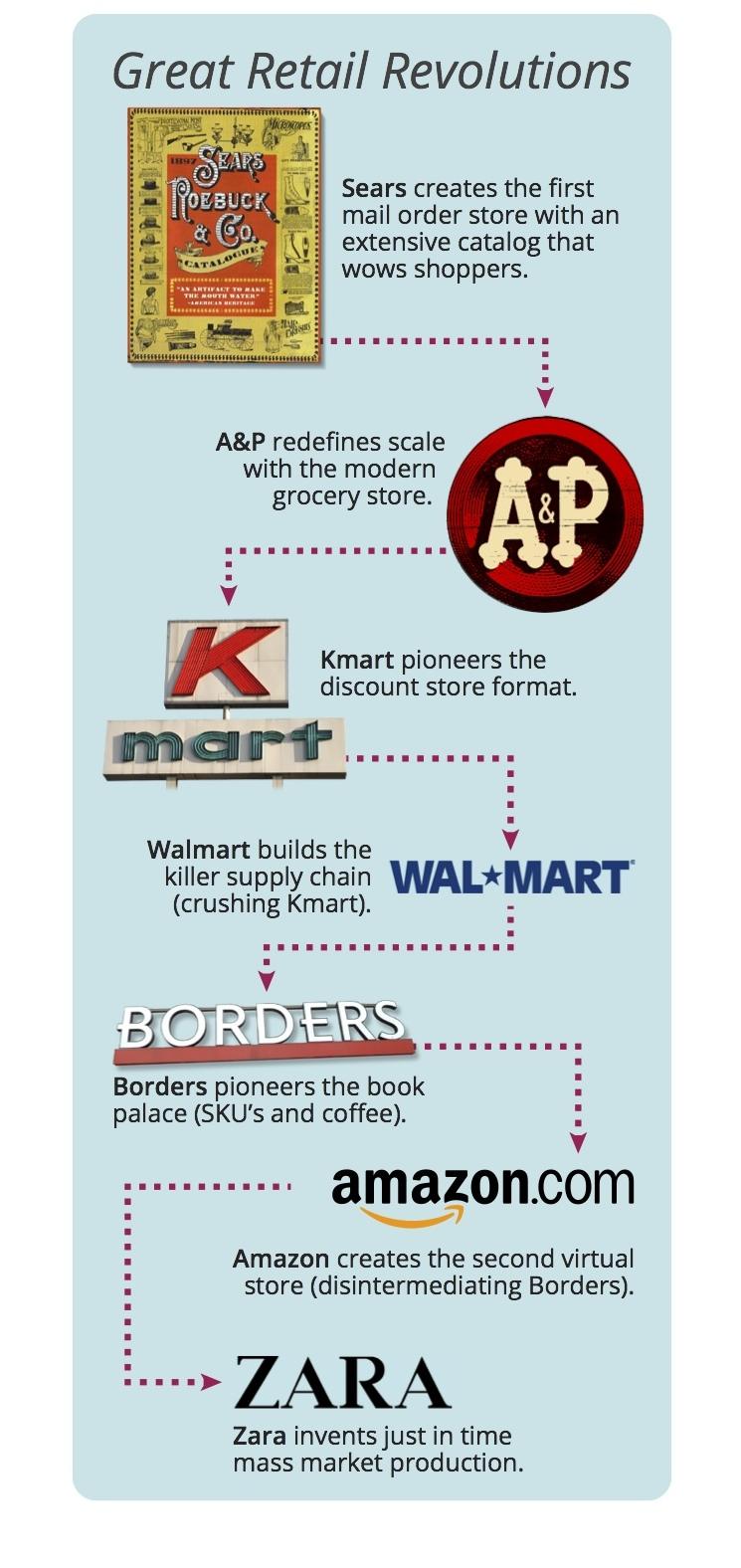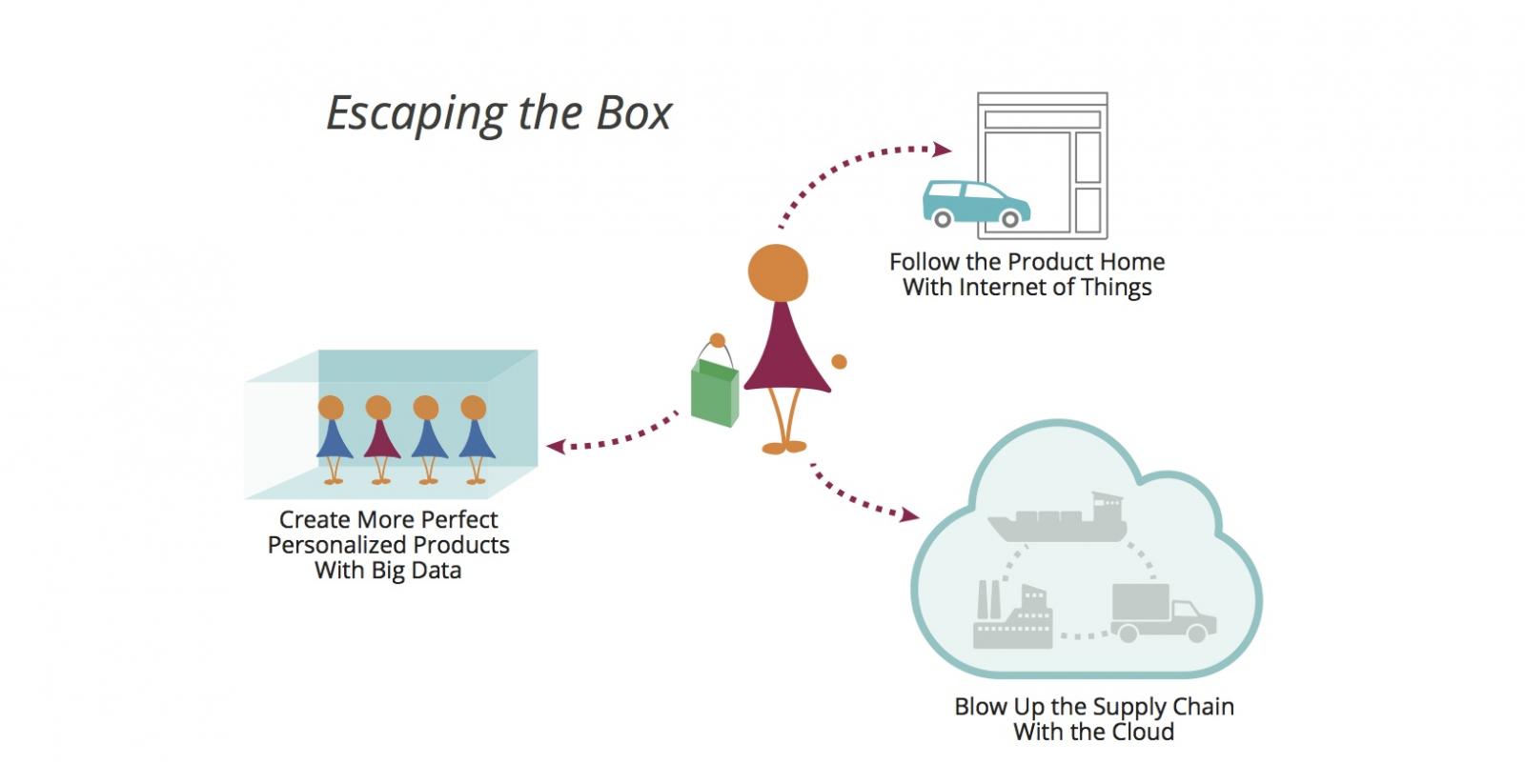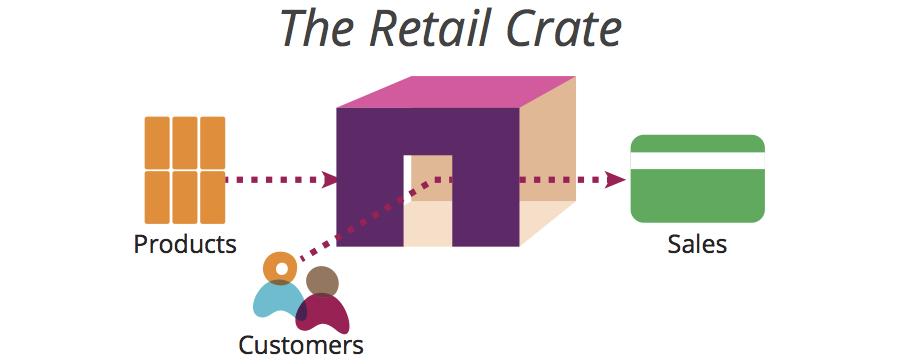
Part 1: Exploding The World of Retail Opportunity - It's Time to Have a Crisis

This doesn’t mean that retail is dead, or that the only remaining opportunities are for commoditized “dog eat dog” battles that squeeze tiny margins out of exhausted markets. Even as grim battles are waged to scrape a little more meat off the retail industry’s old bones, untapped opportunities remain to create value.
We Need A Good Crisis
We need to embrace a crisis. For the last century a store has been defined by four walls that enclose a selection of products. It’s a crate within which we do commerce. At the turn of the last century, Dan’s (One of the article’s authors) great grandfather and his brother-in-law had a general store in Pittsburg, Kansas. Their job was to put things inside the four walls and serve customers who arrived in horse drawn wagons to take those products away. Today, the crate may be a mixed format superstore with a just in time supply chain, but it’s still doing fundamentally the same business.
The digital revolution didn’t do much to change this model. When we talk about online commerce, we use the language of stores. In a very real sense the retailer’s job is just to put things inside our smartphones and then let us buy them. Things go into the crate and people take them out.
What has changed is that everyone is exceptionally good at this set of skills, so the opportunities to differentiate and build margins are vanishingly small. New technology that is used to do old things rarely produces breakout wins. Advances in mobile technology can and should be used to create an easy shopping experience in-store, mitigate the pain of POS execution, or do a better job of providing margin-eating discounts to the very best customers. But none of those things will restore margins in a market where the underlying value of “putting things into a crate so that others can take them out” has become a commodity. Physical stores need to rethink their purpose.
Escaping the Crate!
It’s time to seek voices and ideas from outside retail’s four walls. The same technologies that power better versions of a commoditized business model can be used to explore new territory and deliver value propositions that remain untapped in modern retail. We are going to look for these opportunities with three different lenses. In each, the physical store, is a small part of a much larger set of opportunities that create value for customers and suppliers.
-
Follow the Product Home – The point of sale is just one step in the customer’s acquisition and use of a product. Long chains of cost and value, largely untapped areas of opportunity and disruption, extend out on either side of the customer’s sales interaction with the crate.
-
Deliver Solutions, Not Products – The idea of selling a “thing” is based on the concept that customers will be responsible for using it to create value in their lives. What happens when retailers engage more directly in delivering that end value?
- Make Every Product Personally Perfect – Stores exist because there are products to put inside them. When it becomes possible to custom tailor products to the unique needs of each customer, the crate’s purpose will become something quite different.
This Is Hard Work
When anyone makes the claim that there are riches to be had in some new idea, it is always worth asking, “Why hasn’t this been done yet?” That should be particularly true of anyone pitching ideas that take a sharp turn off the well-worn path.
Part of the answer is that there has been a lot of money to be made within the traditional retail model. This is the classic trap Clayton Christensen identified for established industries: when things work well and at scale, it is hard to create the momentum for change. The more radically different an idea seems, the greater the barrier to strong creative pursuit. All three of these opportunity spaces will seem strange to those ingrained in the traditional retail mindset. Why break your business model, when you could simply build a mobile app for online ordering?
It’s not just internal resistance to change. Each of the three “outside the crate” opportunities requires building complex business systems that mix many different skills. There are a lot of moving parts… and many of the parts are new and untested. Fortunately, new technologies are emerging that dramatically extend our capabilities and shift the economics of these strategies.

Each strategy is fueled by a powerful new technology trend. The internet of things (IOT), big data, and the cloud are more than buzz words in this context. They unlock new opportunities that have been off limits to retailers.
The Great Crate Escape Begins
Investing in being better at an exhausted business model is like squeezing a rock harder. The well understood world of operational optimization for internal benefit has vanished. So, how might retailers find a way to matter more?
The first step is to let go of our fixation on a field of play that has become increasingly barren, to step out of a box that has become a trap. Retailers who survive and thrive in this new world will be those that look outside the retailer crate instead of trying to reinvigorate a space that has become commoditized, or simply irrelevant.
The great escape has already begun. When Amazon places a Dash button in your laundry room, the meaning of the store begins to shift. When young professionals stop buying cars, and simply Uber when they need to go somewhere, the meaning of product changes. When a replacement knee is uniquely designed and constructed to fit a specific patient, it is more than just a medical advance. Mass market supply shudders.
None of these opportunities lie inside the retail crate. They call from a world that is rich in diversity and complexity. Shed the traditional view of what retailers do, where and how they do it, and all sorts of doors open up.
Each part of this series will explore a different type of opportunity that exists outside traditional retail. Like all big changes these opportunities will seem like speculation on the fringe of business, until they are suddenly obvious and urgent. We believe retailers are now in the sweet spot for exploring and acting on these possibilities.
Examples and test cases are present in the world, but the full promise has yet to be made obvious. It’s a good time to have a crisis… and to make an escape.
This is the first of a five part series. Read part two here.
Disclaimer: The statements and opinions expressed in this article are those of the author(s) and do not necessarily reflect the positions of Thoughtworks.















